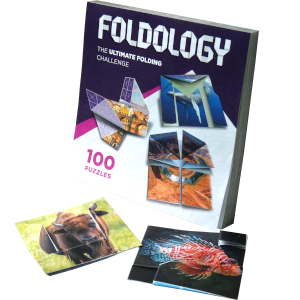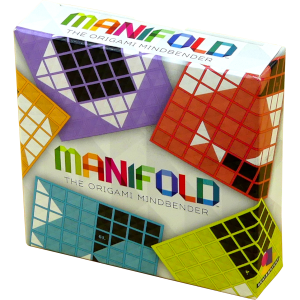Best Origami Puzzle Games of 2020
PuzzleOwl's In-depth guide to the best paper-folding brain teasers of 2020, an amazing but not widespread category of puzzles. I love the level of concentration and spatial thinking that these puzzles require.
Updated November 2020
The origami paper-folding concept makes for some excellent puzzles and brain teasers. I first came across Foldology, and I liked the concept so much that I looked for more puzzles in this category.
Although it's not how people typically think about origami, the puzzles are actually really compelling and an awesome challenge for spatial abilities. Below, you'll find my take on the best origami puzzles I've found. Each game has multiple folding challenges that will keep you entertained for hours on end.
Recently, mobile apps based on this same origami puzzle concept, such as Paperama, have exploded in popularity. But all these apps really can't compare to the real thing! Why drag your finger across a screen when you can hold real paper in your hands? You're missing out on half of the whole essence of paper-folding (the actual folding).
For a puzzle to be excellent, it has to be both challenging and fun. This principle is at the core of my philosophy for choosing great puzzles. A really great puzzle presents a monumental challenge while still being incredibly fun to solve. Figuring out something really complex, while staying engaged and enjoying the process, is one of the most satisfying experiences you can have. It's this feeling of accomplishment and discovery that defines and separates puzzles from other forms of entertainment.
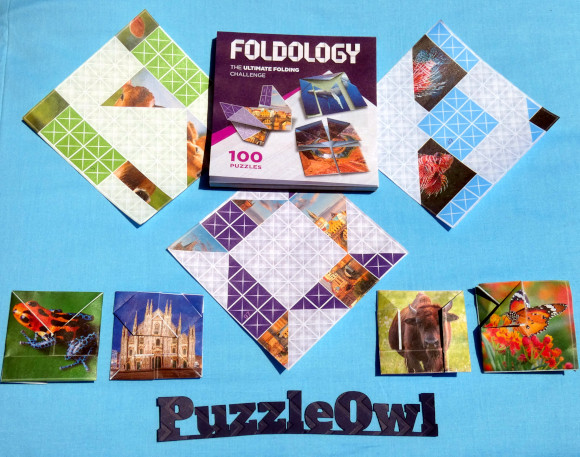 Fun:
Fun: 
Portability: 
Value: (35 Hrs+) 
Difficulty Progression: 
Good for Kids? (11+ Best) 
The goal for each of the 100 challenges is to figure out how to fold it to put the picture back together.
This game is exceptionally well-designed. The puzzles start easy, but ramp up quickly. Each subsequent brain teaser has something new or more complex than the preceding ones, so it doesn't get boring or hit a plateau. The art on each puzzle is very visually pleasing with nice photos of animals, landscapes, and landmarks.
What Stands Out
Great difficulty progression: you're able to dive right in with no previous origami experience, learn new folding techniques as you go along, and be consistently challenged as you work through all 100 puzzles. By the end, the puzzles get amazingly elegant, complex, and very satisfying to fold.
Deep Sensory Engagement: First, it's something that you're manipulating with your hands; so you're folding, turning, tucking, pinching one corner while simultaneously creasing another. At the same time, you're incredibly zoned-in visually because you have to continuously pay attention to how the paper looks after every fold that you make. It's a precise yet tactile activity, which is a fairly unique combination. It leads to a full mind-meld as your hands and mind work in concert towards the solution.
Great Quality: Vibrant colors and high-quality printing. The paper is especially thin but also extra durable, which makes it perfect for folding. This allows you to try out many folds before getting to the solution.
Nice Balance: These puzzles get really challenging, but they're also super satisfying to complete. Solving the puzzles involves a fair amount of both experimentation and strategic thinking, which makes them really fun.
Drawbacks
- The packaging is nothing fancy, the booklet comes wrapped in clear plastic.
- You have to fold the puzzles pretty carefully if you want the pictures to look good.
Bottom Line
Foldology is an awesome, gripping logic game that brings great value in 35+ hours of playing time. It definitely builds up to a high level of challenge, but that's balanced out nicely by the satisfaction you get solving it, and working your way up the stack into the really elegant puzzles at the end.
Another nice thing is that you can get a single copy of Foldology, but then share the puzzles with your loved ones and friends. It's really a lot of bang for your buck. This would make a great gift for anyone into origami, anyone into puzzles, even someone who just wants a mindfulness-inducing activity for a part of their day.
See My Full Review of Foldology
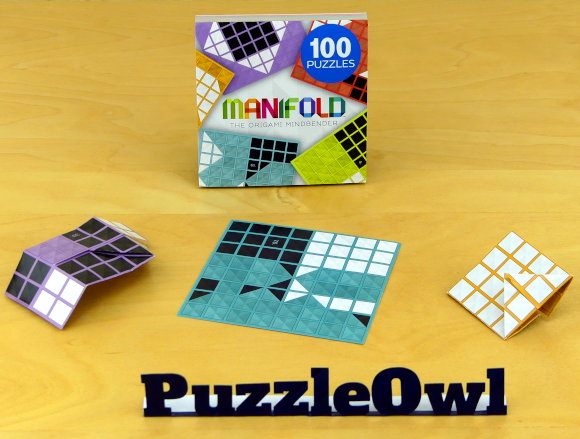 Fun:
Fun: 
Portability: 
Value: (30 Hrs+) 
Difficulty Progression: 
Good for Kids? (11+ Best) 
Manifold "The Origami Mindbender" is another amazing origami puzzle. Just like Foldology, there are 100 brain teasers included, and the basic setup is very similar. The one big difference between the two games is that Foldology has pictures, while Manifold does not. The difficulty progression of this puzzle is a bit more measured and doesn't ramp up quite as quickly.
In Manifold, each puzzle has some white colored fragments and some black ones. The goal is to fold each puzzle into a smaller square so that one side is all white, and the reverse side is all black.
What Stands Out
Great Packaging: Manifold comes in a sturdy, colorful box and it looks great. That makes it a pretty attractive gift.
Meditative Fun: These challenges ramp up steadily and hit a pleasant stride in the middle, so solving these puzzles is a nice, mindful, and meditative activity. That makes these puzzles a great accompaniment for listening to an audio-book, or just winding down after a long day.
Deep Sensory Engagement: This is something that applies equally to both Foldology and Manifold, so it's worth repeating. First, it's something that you're manipulating with your hands; so you're folding, turning, tucking, pinching one corner while simultaneously creasing another. At the same time, you're incredibly zoned-in visually because you have to continuously pay attention to how the paper looks after every fold that you make. It's a precise yet tactile activity, which is a fairly unique combination. It leads to a full mind-meld as your hands and mind work in concert towards the solution.
Drawbacks
- It's printed on slightly thicker, glossy paper that may cause some mild frustration.
- Some of the edges can be a bit thick and get in the way of a clean fold.
Bottom Line
Manifold is a solid origami folding game. It doesn't have any pictures, but that might be a plus for some people. This simplicity, combined with a milder difficulty progression might make this a more zen-like game that will appeal to origami and puzzle lovers alike.
You can't go wrong with either this one or Foldology. Whichever one you get, you'll probably like it so much that you'll get the other one too, just to get more folding puzzles.
With 100 challenges, this game packs some great value and it looks great too, making it an excellent gift.
Also Considered
Fold - Fat Brain Toys
This is the third paper-folding puzzle set that I considered for this guide. It also ranks as third for me among these puzzles.
It's designed by Ivan Moscovich, a pretty famous puzzle designer. There are actually 10 different types of folding puzzles in the set. And each type comes with a few challenges, so there's quite a bit going on here.
Of the 10 puzzle types, it was pretty hit or miss for me. I really enjoyed challenge #4 "Three By Four Rectangle" and #6 "Four Square", but wasn't too keen on the others. On top of that, these folding puzzles are printed on very heavy paper that makes it hard to fold flat for some of the challenges.
Bottom Line: Cool variety with 10 different challenge types, but not my top pick for origami puzzles.
About This Guide
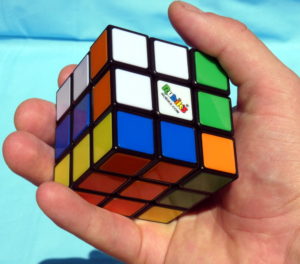
Puzzles have been a passion of mine from youth, starting from when I was first introduced to the Rubik's cube. That is a legendary puzzle that's permeated our society, but puzzles have evolved tremendously since then. Today, there are countless puzzles out there, and new ones are coming out each day it seems, it's getting hard to keep up! It's a great time to be a puzzler.
At the top of this page are just a few of my favorite puzzles, brain teasers, and logic games that are in my collection and took part in this review. Some of these puzzles I've had for quite a while and it was really nice to have a reason to dust them off for a bit of research. Many other puzzles I've bought just this year, to make sure this review is truly current for 2020. I selected just upwards of 60 puzzles to analyze as candidates for this review, and left out many others that I knew straight away wouldn't be strong contenders.
It's been a real pleasure for me to go through all of these and put together this guide. It's one thing to just play with a puzzle, and quite another to do so while consciously looking to pick out the best ones.
PuzzleOwl is my passion project, and as a guy who loves puzzles it gives me joy to write these reviews and help people find amazing puzzles that they'll love. Please support PuzzleOwl by using the links on this page if you're interested in a product, because I may earn a commission from Amazon if you buy something. It has absolutely no impact on the price you pay, and it allows me to keep this site up and running.
Selection Process
Let me start by acknowledging that there are many good puzzles out there of many different types — too many to count. That fact alone guarantees that different people are going to have different favorites. For example, I know a lot of people who love twisty puzzles above all else, while others are really into disentanglement puzzles instead.
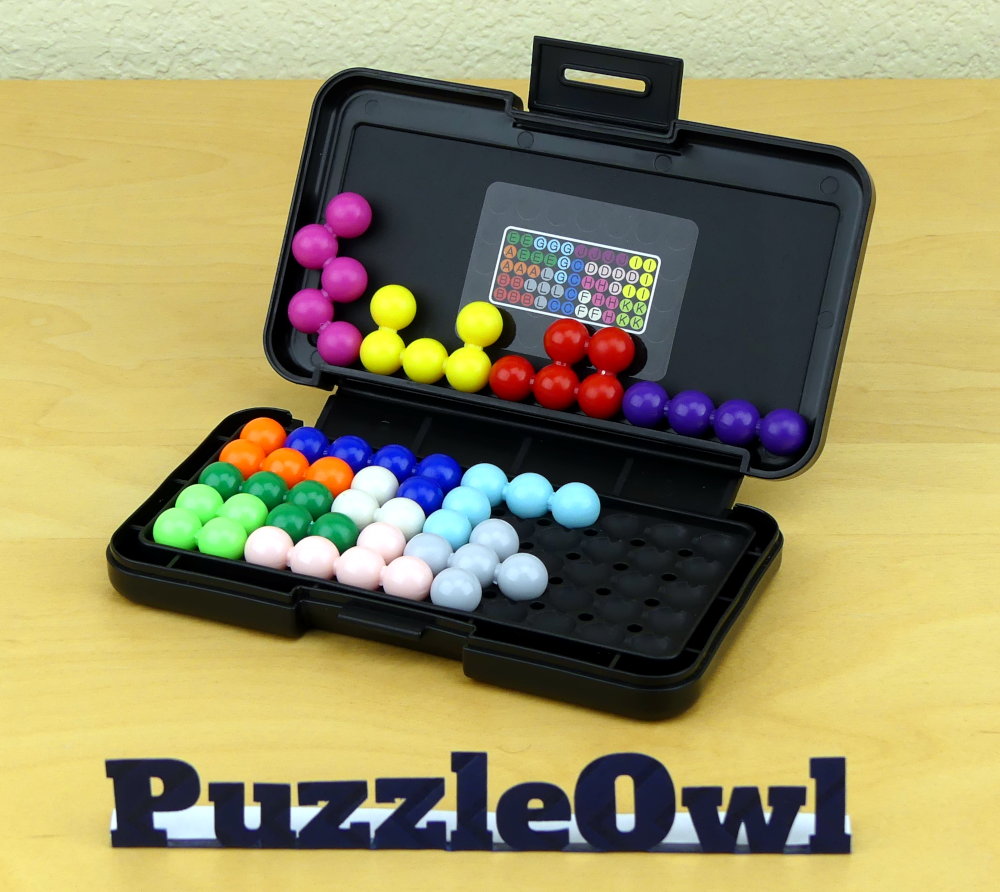
Taking this into account, this guide was put together with an express intention of broad appeal, and avoiding the puzzles that are overly niche. I chose puzzles with simple, elegant concepts that would challenge and delight novice and veteran puzzlers alike. Just below, I'll summarize briefly what I look for in puzzles and how I evaluate them, but you can read about in more detail here. I encourage you to give this page a gander if you want to understand how the puzzles here earned their spot.
First, this guide is about puzzles, not just games, and also not just abstract stuff like riddles. More specifically, for the purposes of this guide, a puzzle has these characteristics:
- It presents a challenge to be solved. Not just a game.
- It's single-player
- It's a real, physical object
- it's challenging but also fun.
To briefly sum up what makes a great puzzle stand out, it comes down to the following:
- an elegant, intuitive concept that's exciting right away
- balance between challenge and satisfaction
- the more challenging the better, provided that it's still fun
- balance between experimenting and strategy
- good design that complements and enhances the core puzzle concept
- good quality of manufacturing and materials
- the only frustrations in the puzzle should arise from the concept, not how the puzzle was made
- value in terms of quality puzzling time for the price you might pay

